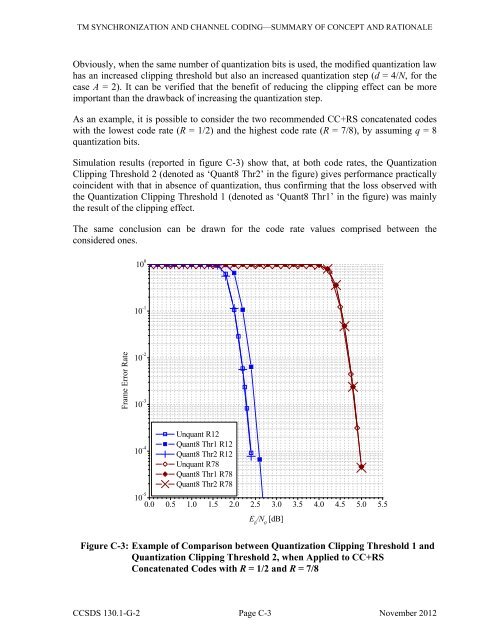130x1g2 - CCSDS
130x1g2 - CCSDS
130x1g2 - CCSDS
Create successful ePaper yourself
Turn your PDF publications into a flip-book with our unique Google optimized e-Paper software.
TM SYNCHRONIZATION AND CHANNEL CODING—SUMMARY OF CONCEPT AND RATIONALEObviously, when the same number of quantization bits is used, the modified quantization lawhas an increased clipping threshold but also an increased quantization step (d = 4/N, for thecase A = 2). It can be verified that the benefit of reducing the clipping effect can be moreimportant than the drawback of increasing the quantization step.As an example, it is possible to consider the two recommended CC+RS concatenated codeswith the lowest code rate (R = 1/2) and the highest code rate (R = 7/8), by assuming q = 8quantization bits.Simulation results (reported in figure C-3) show that, at both code rates, the QuantizationClipping Threshold 2 (denoted as ‘Quant8 Thr2’ in the figure) gives performance practicallycoincident with that in absence of quantization, thus confirming that the loss observed withthe Quantization Clipping Threshold 1 (denoted as ‘Quant8 Thr1’ in the figure) was mainlythe result of the clipping effect.The same conclusion can be drawn for the code rate values comprised between theconsidered ones.10 0 Unquant R1210 -1Frame Error Rate10 -210 -3Quant8 Thr1 R1210 -4Quant8 Thr2 R12Unquant R78Quant8 Thr1 R78Quant8 Thr2 R7810 -50.0 0.5 1.0 1.5 2.0 2.5 3.0 3.5 4.0 4.5 5.0 5.5E b/N 0[dB]Figure C-3: Example of Comparison between Quantization Clipping Threshold 1 andQuantization Clipping Threshold 2, when Applied to CC+RSConcatenated Codes with R = 1/2 and R = 7/8<strong>CCSDS</strong> 130.1-G-2 Page C-3 November 2012

















